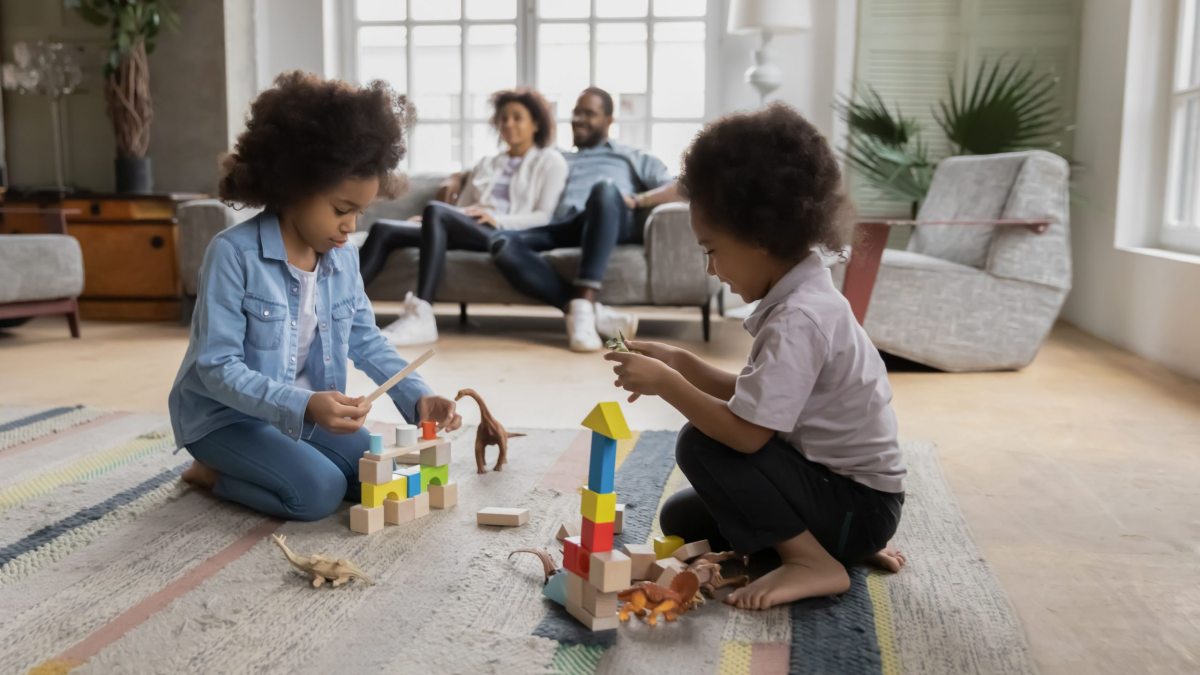Creativity and toys: what’s old is always new
Like actors in improvisational theater, children create in the moment, especially when playing with toys, says education professor Keith Sawyer, an expert on creativity and children’s play.

If you’re looking for toys to make a child’s imagination blossom, turn to the classics.
That’s what Keith Sawyer, the Morgan Distinguished Professor of Educational Innovations in the School of Education, says. An expert on creativity and improvisational play, he became extremely interested in how children play while working on his doctoral dissertation, which led to his first book “Pretend Play as Improvisation.”
During graduate school at the University of Chicago, Sawyer played piano for the Chicago Improvisational Theater Group at night. By day, he visited a preschool classroom at the University of Chicago Laboratory School. He sat on the floor, next to different groups of children, and stationed a microphone close enough to record their voices while they engaged in fantasy play.

Keith Sawyer
“I was focused on conversational dynamics between the children. For me it was always about the social interaction and the conversational patterns, and they’re completely improvisational,” Sawyer said.
He found that, just as actors in improvisational theater do, children improvise and create in the moment, especially when playing with toys.
Today, he still studies creativity, sometimes inspired by the toys, puzzles and games on his office shelves.
Social play and open-ended toys
By age 3, children generally will become interested in pretend play with other children, complete with dialogue. Open-ended toys help.
“When they’re younger than 2 or 3, they don’t engage in true conversation. Instead, each child creates their own world, sometimes called parallel play, so they’re not really conversing with each other,” Sawyer said. “By the time they’re three, they can enact an imaginary scenario, and that’s where their talk becomes completely improvisational.
“That kind of pretend play helps children engage in conversation and talk at a higher level in everyday life when they’re talking about real stuff with their parents.”
‘Can’t go wrong with the classics’
Among the best toys for children, Sawyer recommends classics that foster creativity and improvisational, unscripted play: blocks, TINKERTOY sets, dinosaurs, kitchen play sets. Toys that children have played with for, in some cases, generations.
“You can’t go wrong with the classics. You don’t have to spend a lot of money on toys that foster creativity,” Sawyer said. “The key is to find open-ended toys, not the highly representational toy that looks exactly like a movie or TV character. Then, the child probably will play from the movie script, right?”
On the other hand, when Sawyer observed the classroom, a popular movie was “The Land before Time,” and many of the children performed scenes from the movie with dinosaur figurines. The movie structured their play, and yet, they improvised variations on the movie’s plot.
While Sawyer said that there is nothing wrong with a movie-specific toy for, say Buzz Lightyear, a more abstract or more generic spaceman creates potential for all kinds of space-related play. “I tend to think there’s more potential for creative improvisation if whatever they’re playing with can be interpreted in a lot of different ways.”
A father himself, Sawyer said that children usually integrate objects into their play, in many cases some sort of plastic animal like a dinosaur. “They’ll move them around and talk for them. It’s particularly fascinating the way they voice these toys. If a toy allows you to speak in many different ways, then you have a lot more flexibility to be creative. If you’ve got Buzz Lightyear, from the Pixar movie ‘Toy Story,’ you’re going to talk like him, but if it’s a little dog toy, a dog could be anywhere and say anything.”
‘What’s old is new again’
Colored blocks have been around since the 1800s when Friedrich Froebel, the German educator who created the first kindergarten, developed a system of age-appropriate colored blocks and cylinders for building.
“They are absolutely an example of what’s old is new again,” Sawyer said. “Kids were playing with wooden blocks 200 years ago. You can’t go wrong with that. Most parents these days already have wooden blocks. If you don’t, I think you should go buy some.”
Sets with multiple pieces that fit together, such as Legos, can lead to all sorts of imaginative building: construction site, hospital, dollhouse, village. Sawyer is a fan of such toys because they provide more stability than blocks for building structures.
For older children, Sawyer said that erector sets also ignite creativity. “When I was growing up, I played with an erector set and those still exist. You use a screwdriver to screw long pieces of metal together and make objects.”
A tradeoff
The highest structured play is the most scripted, according to Sawyer. “Let’s say you and a friend are playing with a SpongeBob doll and a Patrick doll. You’ve both seen all the SpongeBob episodes, and you could end up essentially doing a dialogue straight from the TV show. It would be scripted and structured and would seem very sophisticated. But it wouldn’t require as much creativity.”
It’s a tradeoff, he said, between a higher level of conversational sophistication and a lower potential for creativity and improvisation. “If two kids with wooden blocks are playing with each other, there will be a huge amount of creativity and wide range of possibilities, but their dialogue would not sound as sophisticated,” Sawyer said.
That’s why character-specific toys can be good to add to the toy box mix, he added.
Sawyer also sees advantages for toys without an obvious gender, such as dinosaurs. “Boys and girls can play with dinosaurs together, and they can enact the dinosaurs speaking in a stereotypically female voice or in a stereotypical male voice, or some combination. Dinosaurs have that flexibility of not channeling children’s speech into one particular gender role.
A simple formula for parents
So, the simple formula for creating social, imaginative play is combining children of similar age and some toys (when pandemic restrictions lift).
“Just get them in a room together and give them a pile of stuff,” Sawyer said. “Honestly, the message for parents is, ‘Don’t worry; you’re not going to mess it up.’”




